Tribute To A Legend – 3-23-2021
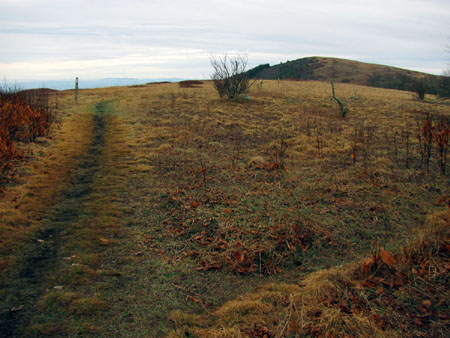
The Clyde Smith Memorial Sign
I (Randy ‘RAT’ Tarpley) have been a member / trail maintainer of the Carolina Mountain Club (CMC) since Spring of 1991. This year (2021) marks my 30th year on the same section (Spivey Gap to Little Bald). It was recently divided into two sections, I now maintain only from Whistling Gap to Little Bald. When I was first considered for the section trail maintainer position, I met at Spivey Gap with veteran trail maintainers Jack Springston and Dwayne Stutzman, where we hiked up to High Rocks and back. Along the way up, we built two large ‘rock water bars’ for which Jack was so famous for. They taught me that process and how regular water bars were made using both wood, rock, and various digging techniques. By days end they were convinced that I was suitable to be the maintainer for this section. It was on that day they told me about an old sign somewhere high on Little Bald, on the old AT that had since been relocated off the main ridge. It was honoring a trail legend and master sign maker, Clyde Smith. The name did ring a bell as I had been to the AT shelter named for him in the Roan area before. I had no knowledge at that time of who he was or what his accomplishments were. I would eventually learn all that later.
My ‘RAT > PATROL’ cohorts and I would spend the most of the first year (1991) building 31 water bars up the North side of the High Rocks overlook. These were previously laid out by Dwayne Stutzman and CMC trail crew as they had been flagged with locust trees already cut for them. Building those and some rock steps up the South side of High Rocks would last into 1992. During this time my friend and main helper Tommy ‘Boulderman’ Warden and myself, could not stop thinking about the old sign for Clyde Smith. Eventually curiosity would fuel our need to get to the summit of Little Bald where we would hike the ridge line back on the old AT, in order to look for the sign. At that time we had no trouble and went right to it. Unfortunately, we did not carry cameras very often back then (this was during the film era) so we did not get a picture of it. We did make mental notes of its location yet, It would be some 20 years later before we would search for it again. Strangely enough, it would not be so easy to find then.
Within the last decade, there must have been at least five or six trips made down the old ridge trail, (now mostly reclaimed by Nature) by Tommy, my son Tyler, and I, before the old sign was found again. I will give credit to Tommy for this and with his directions my son and I would also find it on our next trip there. Sadly, a large part of the old sign is now missing with only one board remaining. My regret of not getting a picture of it or even writing down a description of its wording weighed even heavier on me than before. From that moment on we decided a new sign was in order.

This also started my desire to learn more about Clyde Smith so, I began my research looking for everything I could find. Hoping to learn not only about his life but, also to discover who made/placed the sign there, when it was done, and hopefully to locate a picture of it. I assumed that the family or CMC did it shortly after his passing and prior to the trail being relocated off that part of the mountain. I hoped that the CMC would have records of it in their archives. Of course that turned out not to be the case ! Apparently back in the late 70’s and 80`s there was not an efficient system of keeping records since it would all have been done on paper spreadsheets. Even if there had been it could have easily been lost over the years and during transition to the new digital computer age which was done around 2010. To make matters worse, all the old timers that would have known details about it are now deceased so, I kept hitting dead ends.
After sending out an inquiry to the CMC, I did manage to find out from my friend Morgan Sommerville, Regional Director at Appalachian Trail Conservancy, that the trail had been relocated off the ridge line of Little Bald by the time he came here in 1983. We both agreed that it was most likely Jack Davis (President of CMC 1974 -75 and maintainer for many years after) that was in charge of the relocation via the Optimal Location Review (OLR) process. It was done in the early 80s when the Konnarock Trail Crews were established to assist with these type projects. I worked with the Konnarock Crews for many years during the 90`s doing relocations on my section and others. We concluded that the sign was placed sometime between his passing in 1976 and 1980 when the trail relocation plan was started.
A shelter built in 1977 by the Forest Service on Iron Mountain near Little Rock Knob originally named Roan Highlands Shelter, was later named after him thanks to Ray Hunt (then chair of the Tennessee Eastman Hiking Club (TEHC) ). It was renovated in 2002 by TEHC and Hard Core as an extended roof and eating area was added.
I had almost given up all hope of getting any further information about Clyde Smith and the memorial sign that was made for him. That is, until I discovered an amazing book titled ‘Grandfather Mountain, The History and Guide to an Appalachian Icon‘ written by author Randy Johnson. This piece of literature was like a Godsend for me as it not only contained the most metticulously detailed collection of one of my (and Clyde Smith`s) favorite mountain areas but, it also had information pertaining to the history of Clyde Smith ! I think that my buying that book was fate as it brought about my contact with the author who shares my enthusiasm for Clyde Smith and the mountains we have all worked so hard to preserve. During my interview with Randy Johnson, I was pleasantly surprised to learn just how much he knew about Clyde Smith that was not included in his book. Also his willingness to share with me what he could, for this article for which I am eternally grateful.
Who Was Clyde Smith ?
The primary source for much of the factual information about Smith came from the 2016 book titled ‘Grandfather Mountain – The History and Guide to an Appalachian Icon’ by Randy Johnson. Smith played a major role creating Grandfather Mountain’s trails in the 1940s, and Johnson says that finding Smith’s old signs there in the mid-1970s inspired him to start the trail management program that kept the privately-owned mountain open after hiker deaths had closed the overgrown trails. Johnson reclaimed Smith’s paths, opened new trails and stabilized public access until a state park was created in 2009. After decades researching Smith, Johnson’s book is an inspiring biography of Clyde and an award-winning tribute to Grandfather Mountain.
Further reproduction of pictures by Randy Johnson or Clyde Smith images from Johnson’s writings is not permitted without written permission from Johnson and the original owner.

Quoting Randy Johnson from an overview of his extensive research, Clyde F. Smith “was a trail man ahead of his time. Born in 1906 in the White Mountain town of Gorham, New Hampshire, Smith married wife Hilda in 1930 and with their new son Clyde H. ‘Mickey’ Smith spent more than a decade living the physically demanding trail lifestyle of a summer fire lookout on Mount Cardigan.
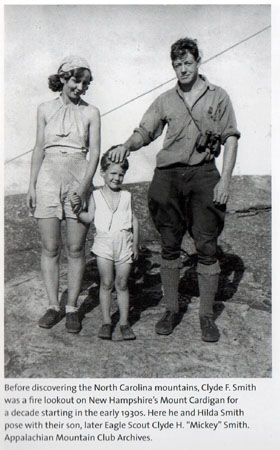
In winter, the couple migrated to South Florida where they worked in the Depression era early tourism economy of the Miami area. Smith got his start as a signmaker in New England during this time, creating routed signs for the trails and even shelters he built near his fire lookout and for local businesses.
By the early 1940s, their winter trips south focused on the Spruce Pine area of the North Carolina Mountains where Smith’s signmaking continued. He fell in love with Grandfather Mountain, and with his son Mickey and a Blowing Rock Boy Scout troop, built the mountain’s earliest formal trails, with cliff-scaling ladders, a trail shelter, and his signature artistic signs.

Smith eventually became a ‘fulltime’ summer signmaker for New Hampshire state parks and continued his family’s seasonal back-and-forth. Smith’s signs found their way to the Grandfather Mountain attraction and a local ski area in the south, and to trails in the White Mountains through his work with the Appalachian Mountain Club and other trail clubs.

Ultimately, Clyde and Hilda Smith were dedicated, lifelong trail volunteers. Smith’s signs made their mark up and down the Appalachian Trail, from Mount Katahdin to the early route across the Roan Highlands.
On April 1, 1976, on a day hike work trip with wife Hilda and a friend, Clyde Smith tragically died of a heart attack on Little Bald, doing what he loved best, maintaining and building trails.”
Johnson says that after returning from Smith’s New England funeral, his wife Hilda and son Mickey met seventeen CMC members at Carver’s Gap on April 21, 1976. The group hiked across to 19-E and had a memorial ceremony for Smith on Hump Mountain.
Almost a year later, Johnson says Mickey was back in Spruce Pine and made a sign memorializing his father. On May 7th, 1977, Hilda and Mickey hiked to where Smith had died and hung the sign on a tree. The sign read, “Clyde F. Smith carved and donated signs and devoted his time improving this trail. On April 1, 1976, gave his life that you might enjoy your hike.” Soon after Hilda Smith returned to New Hampshire.

All that currently remains of the original sign is: ” ,,,TRAIL ON APRIL 1, 1976 GAVE HIS LIFE THAT YOU MIGHT ENJOY YOUR HIKE”.
Thankfully I received a lot of support from the CMC and their current official sign maker, Tom Weaver, who offered to make the sign for us ! He completed it by Jan 29, 2020 and it ended up being reworded as follows: “CLYDE SMITH FAMED TRAIL MAINTAINER & SIGNMAKER FOR THE CMC DIED WHILE WORKING ON THE AT ON THIS SPOT APRIL 1ST, 1976”.
Please note that Tom expressed his dissatisfaction with his work and advised that he would quote: “consider making 2nd Version when my backlog list of signs is caught up”. We were of course very happy with the sign he made in that we would no longer have to wait to get this done. It had been such a long time coming although unfortunately, the Covid19 pandemic postponed getting the sign installed. If another sign is to be made, I am considering that it may be a replica of the original to honor both Clyde and his son Mickey who is also now deceased (he died in 2008).
Replacing the Sign
Finally, Tuesday, March 23, 2021, arrives. It was a cool, breezy morning. My son Tyler Tarpley and myself met fellow trail maintainer Mark ‘Tazman’ Tavzel (who maintains the Big Stamp to Little Bald section that adjoins mine) on Big Bald Mountain. We hiked North to Little Bald and down the ridge line, off trail to reach the location of the old sign. In order to place the sign just below what was left of the old one (which I later plan to carefully remove and preserve) , we would have to stack up some old wood and rely on Mark`s being taller than either of us in order to reach it ! The tree leans slightly up the hill so, I had to hold on to him to provide the leverage needed to drill the large screws into place. I regret that my friend Tommy Warden could not be there for the event but, it was beyond his control. He did give us his blessings to proceed without him in order to finally get this project done. He was definitely there in spirit and I am sure he will be visiting there soon as he can. I hope to make a short, marked side trail to it in the near future. We hope that those who find this spot will enjoy and appreciate all the efforts it took to make it possible.
The following images captured the event on that day and I will also include a link to a short video that we made as well.


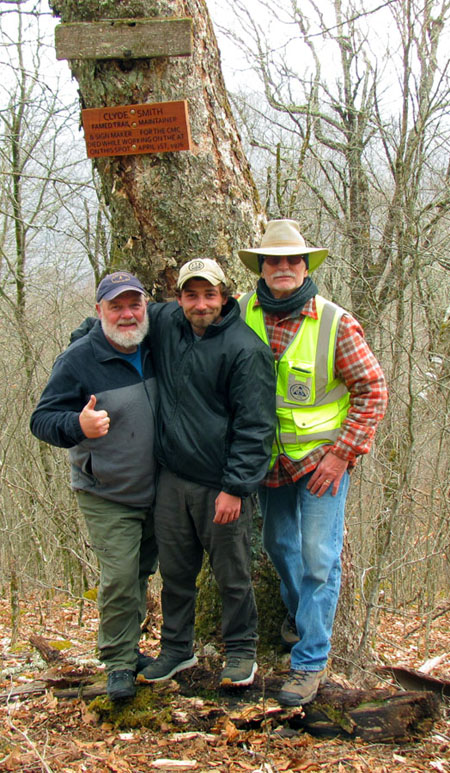
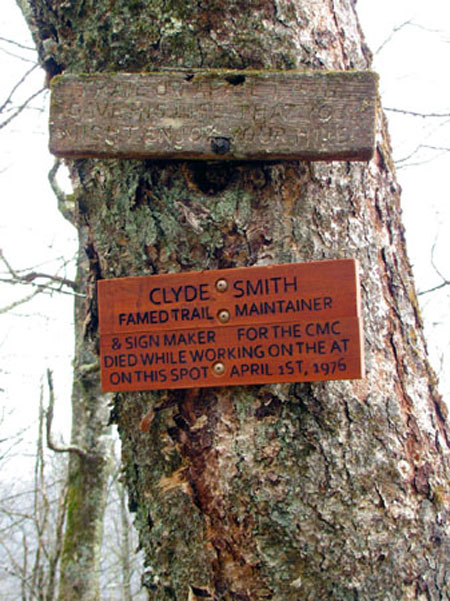
Here is the link to a short video we made that day after placing the new memorial sign: https://www.youtube.com/watch?v=QftWz5BhBx0
I would like to personally thank the following for their help and assistance in making all of this possible:
Randy Johnson (Author of ‘Grandfather Mountain – The History and Guide to an Appalachian Icon’)
Carolina Mountain Club
Paul Curtin (CMC Trail Supervisor) (for reaching out to many other members of the CMC (too many to list here) for info who also deserve thanks)
John Whitehouse (CMC work crew leader)
Tom Seaver (CMC signmaker)
Stuart English (CMC Historian)
Morgan Sommerville (Regional Director at ATC)
Tim Carrigan (CMC member and webmaster)
University of North Carolina Library at Chapel Hill (and Hugh Morton for the pictures he contributed there)
Appalachian Mountain Club Archives
Tommy ‘Bol’Dar’ Warden (lifelong friend and trail maintainer)
Tyler Tarpley (my son)
Mark ‘Tazman’ Tavzel (friend and fellow CMC trail maintainer)
Tags: appalachian trail, AT, clyde smith, grandfather mountain, Little Bald, memorial sign, randy johnson






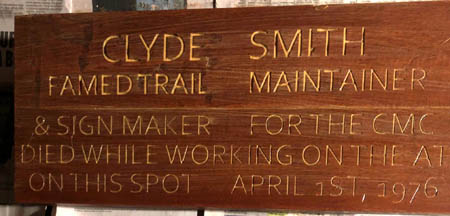

 My name is 'RAT' and I love the mountains and waterfalls of the East TN. area where I live and I hope you enjoy this blog about my outdoor adventures.
My name is 'RAT' and I love the mountains and waterfalls of the East TN. area where I live and I hope you enjoy this blog about my outdoor adventures.





Leave a Comment